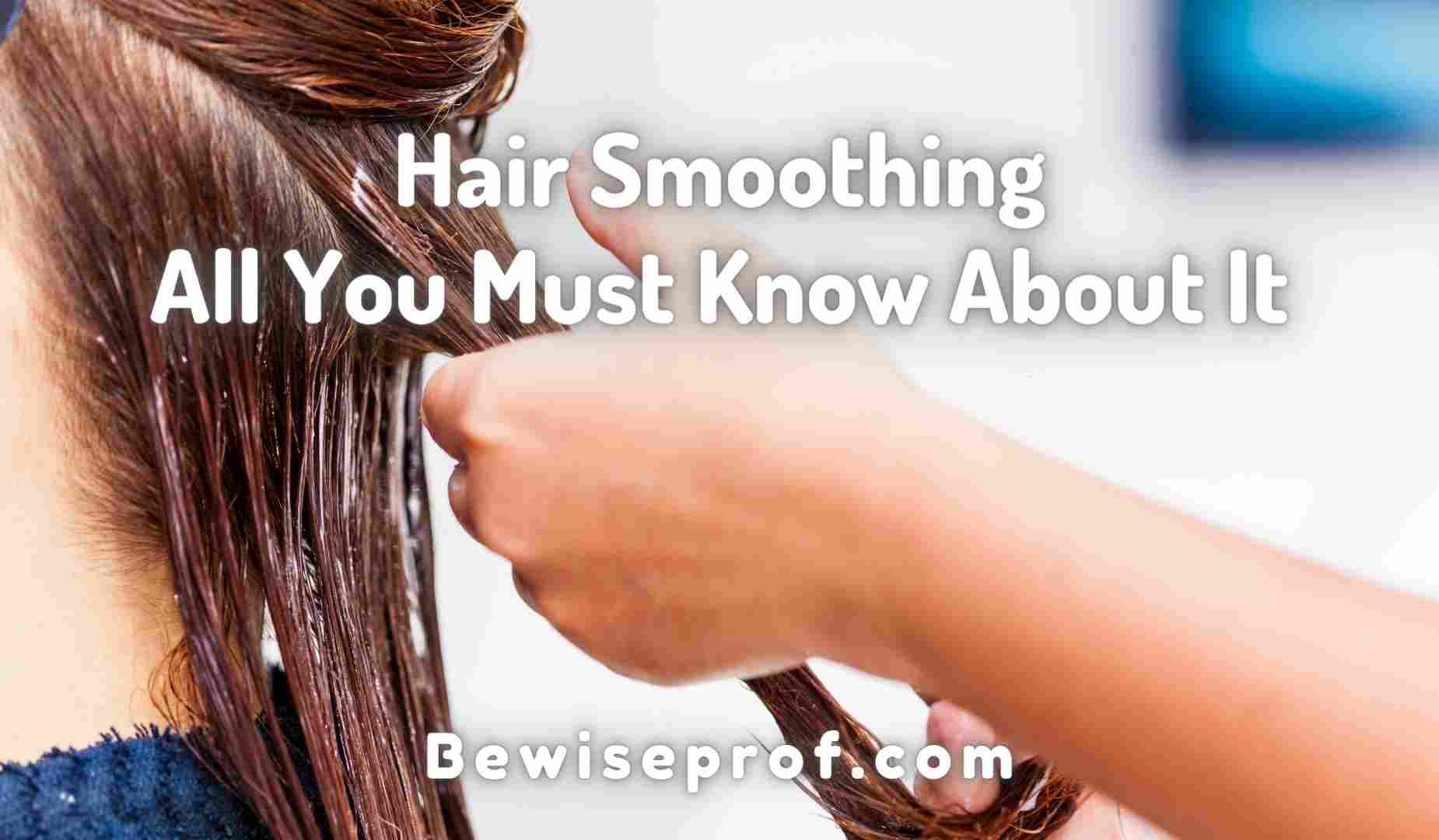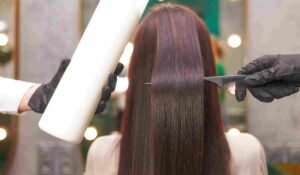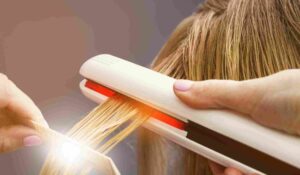Let’s face it: we all dream of silky, smooth hair.Hair smoothing treatments can be a tempting solution for taming frizz and achieving sleek, manageable hair. But how long do they last, who are they suitable for, and what are the potential downsides?
But is there a quick, easy, and long-lasting way to achieve it? Enter hair smoothing treatments.
However, before you book your appointment, there are some important things to consider. While hair smoothing can give you those glossy locks you desire, it’s important to understand the potential impact on your hair’s health.
What the Experts Say
Hair smoothing involves altering the structure of your hair by breaking down its bonds and then reforming them into a straighter shape. This process can be particularly harsh on hair that’s already dry, damaged, or brittle.
What Is Hair Smoothing?
Hair smoothing, also known as chemical straightening, is a temporary treatment designed to tame unruly, curly, or frizzy hair. The process typically involves applying a solution containing formaldehyde (a potentially harmful chemical) to your hair strands, followed by blow-drying and flat ironing to seal in the straightness.
Key Differences from Hair Straightening:
- Temporary vs. Permanent: Hair smoothing is temporary, usually lasting about six months, while hair straightening permanently alters the hair’s structure.
- Texture vs. Shape: Smoothing focuses on reducing frizz and improving texture, whereas straightening aims for poker-straight strands.
Important Considerations:
- Hair Health: Smoothing can damage your hair, especially if it’s already compromised. Consult a professional stylist to assess your hair’s condition before proceeding.
- Formaldehyde Concerns: The chemical used in many smoothing treatments can be harmful if inhaled or absorbed through the skin. Look for formaldehyde-free options if possible.
- Maintenance: Smooth, frizz-free hair requires ongoing care and maintenance. Be prepared to use specific shampoos and conditioners, as well as avoid heat styling as much as possible.
Hair smoothing can be a tempting solution for achieving sleek, manageable hair. But before making a decision, weigh the potential benefits against the potential risks. Discuss your concerns with a trusted stylist to determine if hair smoothing is the right choice for you and your hair type.
The Hair Smoothing Process: A Step-by-Step Guide
Hair smoothing can transform unruly, frizzy hair into sleek, manageable locks. But what exactly does the process involve? Let’s break it down step by step:
Professional Hair Smoothing Treatment:
- Preparation: Your stylist will begin by washing and conditioning your hair to ensure it’s clean and ready for the treatment.
- Application of Smoothing Solution: A chemical solution, often containing formaldehyde (or a formaldehyde-free alternative), is applied to your hair and left to sit for 20-30 minutes. This solution breaks down the bonds in your hair’s keratin structure.
- Rinsing: The solution is then rinsed out thoroughly.
- Blow-drying: Your hair is dried with a blow dryer.
- Flat Ironing: A flat iron is used at high heat to straighten your hair and seal in the new, smoother shape.
- Neutralizer (Optional): Some treatments include a neutralizer cream applied after ironing to further seal the effect. This is left on for 20-30 minutes and then rinsed out.
- Final Wash and Style: Your hair is washed again, conditioned, and styled as desired.
Important Note: Formaldehyde can be a harmful chemical. If possible, opt for formaldehyde-free smoothing treatments or discuss any concerns with your stylist.
At-Home Hair Smoothing Treatments:
While not as long-lasting as professional treatments, there are several natural options you can try at home for smoother hair:
- Hot Oil Treatment: Deeply nourishes and strengthens hair, making it more manageable and less prone to frizz.
- Banana Mask: Bananas are rich in vitamins and natural oils that help smooth and soften hair.
- Mayonnaise Mask: Mayonnaise contains amino acids and antioxidants that can nourish and improve hair texture.
- Apple Cider Vinegar Rinse: ACV helps balance the scalp’s pH and removes product buildup, leading to smoother, shinier hair.
Key Ingredients in Smoothing Products:
Many commercial hair smoothing products contain beneficial ingredients like:
- Biotin: Promotes hair growth and strength.
- Vitamins E and B5: Nourish and protect hair.
- Moringa Seed Oil: Adds shine and moisture.
- Amino Acids: Strengthen hair strands.
- Moroccan Argan Oil & Avocado Oil: Hydrate and smooth hair.
Remember, whether you opt for a professional treatment or try a DIY approach, proper hair care and maintenance are essential for keeping your hair smooth, healthy, and beautiful.
Things to Do Before Your Hair Smoothing Session:
- Research: Thoroughly investigate the salon, stylists, and the specific products they use for smoothing treatments. Look for reviews and testimonials online, and don’t hesitate to ask for recommendations.
- Know Your Hair Type: Different hair types respond differently to smoothing treatments. Understanding your hair’s unique needs will help you choose the most suitable method.
- Beware of Bargains: Avoid suspiciously cheap deals. Quality products and skilled stylists are worth the investment for healthy, long-lasting results.
- Ask About the Products: Inquire about the brands and ingredients used in the smoothing treatment. Reputable salons will be transparent and knowledgeable about the products they use.
- Previous Treatments: If you’ve had hair smoothing before, inform your stylist. This will help them tailor the treatment to your hair’s history and condition.
- Consultation: Schedule a consultation with your stylist before your appointment to discuss your hair goals, texture, and any concerns you have. This ensures you both have realistic expectations for the outcome.
- Salon Environment: Choose a salon with good ventilation, especially if the treatment involves formaldehyde.
Hair Smoothing Aftercare Tips:
- Gentle Products: Use sulfate-free shampoos and conditioners specifically designed for chemically treated hair. Silicone-based products can also help protect the hair shaft.
- Avoid Tight Hairstyles: Don’t tie your hair in tight buns or ponytails for extended periods, as this can stress and damage the hair.
- Oil After 15 Days: Wait at least 15 days before oiling your hair. Then, you can gently massage your scalp and hair with coconut, olive, or almond oil to nourish and restore moisture.
- Hydrating Masks: Occasionally use hair masks to replenish moisture and strengthen your hair.
- Minimize Heat Styling: Limit the use of heat styling tools like blow dryers and straighteners, as they can further damage chemically treated hair. If you must use a dryer, use the cool setting.
- Wait to Wash: Avoid wetting your hair for at least three days after the treatment.
- Sleeping Habits: Sleep with your hair loose and straight to maintain its smooth texture.
- Cool Water Wash: Wash your hair with lukewarm or cool water to prevent moisture loss.
- No Coloring/Highlighting: Wait at least six months before coloring or highlighting your hair to allow it to recover from the smoothing treatment.
- Use a Wide-Toothed Comb: Avoid using brushes, as they can be harsh on treated hair. Use a wide-toothed comb to gently detangle.
- Hair Serum: After a few days, apply a hair serum to protect your hair from environmental damage.
By following these tips, you can maximize the benefits of your hair smoothing treatment and keep your hair looking its best!
How Long Does Hair Smoothing Last?
Hair smoothing is a temporary treatment, with results typically lasting between 2 to 5 months. The longevity depends on factors like your hair’s growth rate and how well you maintain it.
Who Can Benefit from Hair Smoothing?
- Ideal for: Curly or wavy hair that’s prone to frizz. It helps smooth and straighten hair for a sleeker look.
- Not Ideal for: Extremely curly, coiled, or thick hair, as the results might not be as noticeable. Very fine or damaged hair is also not recommended due to the potential for further damage.
Note: It’s generally advised not to exceed three hair smoothing treatments per year. Excessive use can weaken hair and make it more brittle.
Disadvantages of Hair Smoothing:
- Formaldehyde Exposure: Some smoothing treatments contain formaldehyde, a chemical that can cause irritation to the eyes, skin, and respiratory tract, and is considered a carcinogen. Ensure your salon is well-ventilated and uses professional-grade products. Look for formaldehyde-free options if possible.
- Potential Hair Damage: The high heat used during the flat ironing process can damage hair, especially if it’s already weak or brittle.
- Not Suitable for All Hair Types: As mentioned, hair smoothing isn’t ideal for everyone. Those with very fine, damaged, or excessively dry hair should consider alternative options.
Hair Smoothing vs. Hair Straightening:
| Feature | Hair Smoothing | Hair Straightening |
|---|---|---|
| Result | Smooth, frizz-free hair | Poker-straight hair |
| Longevity | Temporary (2-5 months) | Permanent |
| Suitable For | Slightly curly or wavy hair | Curly or very curly hair |
| Chemical Process | Less harsh | More harsh |
Summary:
Hair smoothing treatments are popular for a reason – they offer a convenient way to achieve sleeker, more manageable hair. However, it’s important to be aware of the potential drawbacks and to choose a reputable salon with experienced stylists. Proper aftercare is also crucial to maintain the results and keep your hair healthy.
Alternative to Chemical Smoothing:
If you’re concerned about the potential damage of chemical smoothing, consider using keratin-rich hair masks and other natural treatments to improve hair texture and reduce frizz.
The Bottom Line:
Smoothing treatments can be a great option for some, but it’s essential to weigh the pros and cons and choose what’s best for your hair type and personal preferences. Consult with a hairstylist to discuss your options and determine if hair smoothing is right for you.



